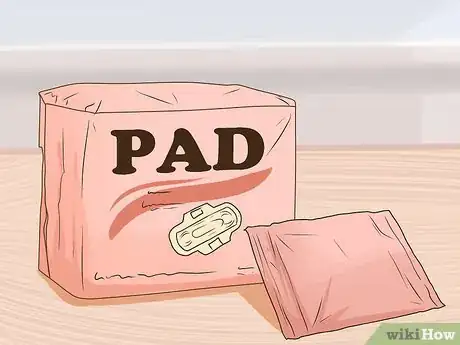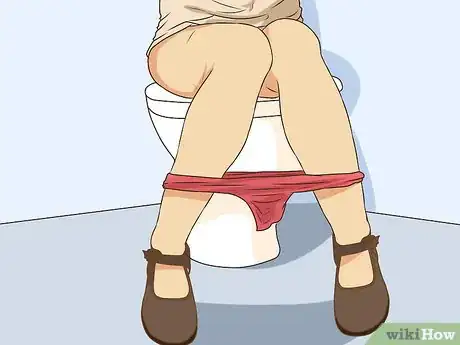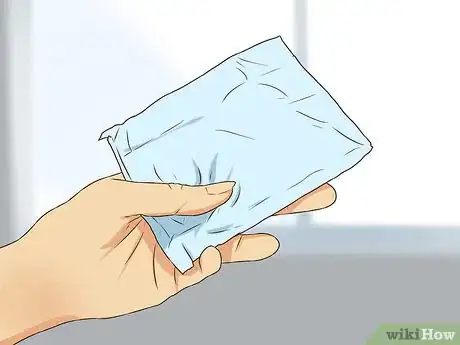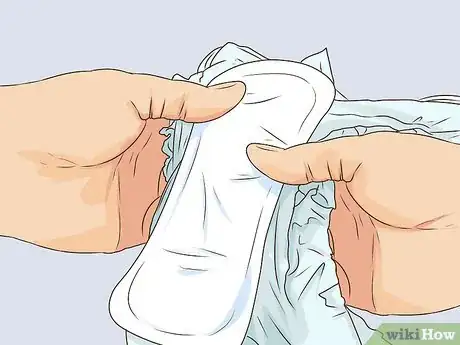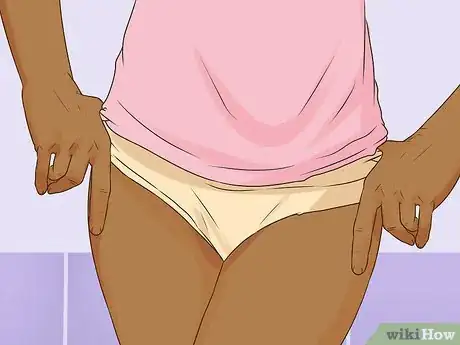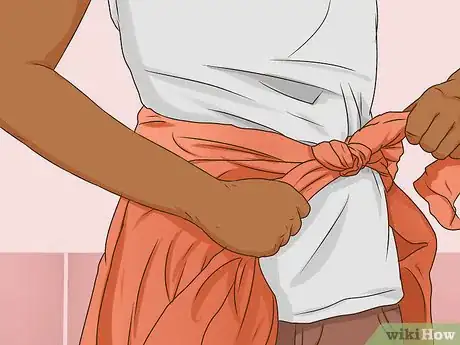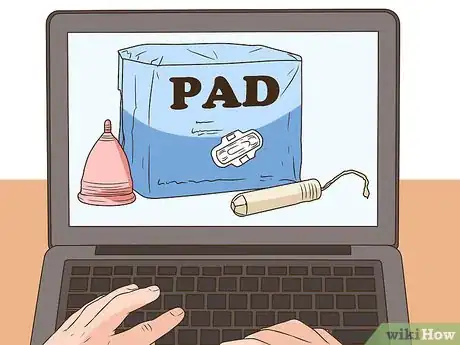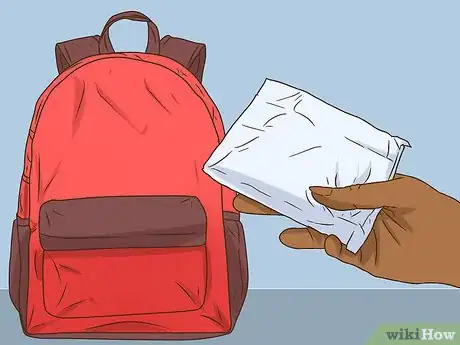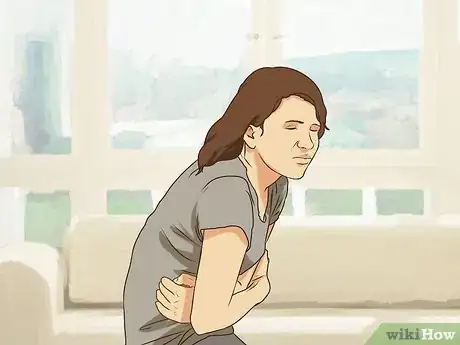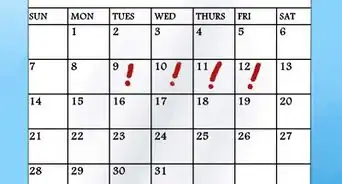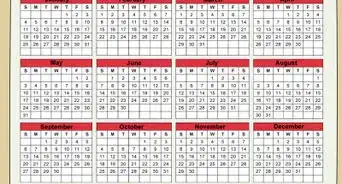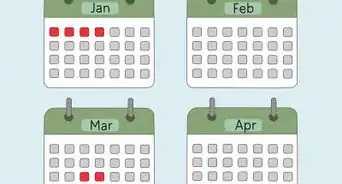This article was co-authored by Luba Lee, FNP-BC, MS. Luba Lee, FNP-BC is a Board-Certified Family Nurse Practitioner (FNP) and educator in Tennessee with over a decade of clinical experience. Luba has certifications in Pediatric Advanced Life Support (PALS), Emergency Medicine, Advanced Cardiac Life Support (ACLS), Team Building, and Critical Care Nursing. She received her Master of Science in Nursing (MSN) from the University of Tennessee in 2006.
There are 9 references cited in this article, which can be found at the bottom of the page.
wikiHow marks an article as reader-approved once it receives enough positive feedback. This article received 37 testimonials and 92% of readers who voted found it helpful, earning it our reader-approved status.
This article has been viewed 138,518 times.
Anticipating your first period can be stressful. You never know when or where it will happen. Considering how much time you spend in school each week, there is a pretty good chance it will happen there. By learning how to use a pad, bracing yourself to be caught off guard, and preparing for your first period in general, you will have no trouble handling your first period at school.
Steps
Using a Pad
-
1Ask someone for a pad if you don’t have one. Perhaps you were prepared and have a pad stashed in your locker, but maybe this isn’t the case for you. Not to worry! Go see your school nurse to ask for a pad, or ask any person in school who you think might have their period. No need to be embarrassed! People sharing menstrual hygiene products is a practice as old as time. It is part of the code of having a period.[1]
- Your bathrooms at school may have a coin-operated dispenser that sells pads.
- If your school has a nurse’s office, the nurse will likely have pads or other period products on hand.
-
2Pull your underwear down to your knees. Go into the bathroom and pull down your pants or skirt and underwear. Sit down on the toilet so any blood will drip into the toilet bowl and not onto the floor or your clothing. Wipe yourself with toilet paper to clean away any excess blood.Advertisement
-
3Unwrap the pad and remove the backing. Carefully open the packaging around your pad and remove it. You may want to save the wrapper for later. It is perfect for disposing of your pad when it’s time to change.[2] Then, remove the backing to expose the adhesive.
- Usually, you will find a long piece of wax-like paper covering the sticky side on the bottom of the pad.
- In some brands, the outer wrapper may also double as backing, so the adhesive may already be exposed when you remove the wrapper.
-
4Center the pad in the crotch of your underwear. On most underwear, there is a cotton panel in the crotch area that you can use as a guide. Basically, you want the pad to cover the part that goes between your legs. If your pad has one wider or bigger side, it should go toward the back of your underwear (toward your butt). Make sure the adhesive is stuck firmly to the fabric of your underwear.[3]
- If your pad has wings, remove the backing and fold them around the middle part of your underwear, so it looks like the pad is hugging your underwear. The wings should be like “arms” wrapped around the crotch of the underwear.
- Make sure the pad isn't too far forward or too far back. It should be centered so you don’t get leaks at the front or back of the pad.
-
5Pull your underwear up. Make sure that your underwear and the pad fit snugly against your body. It might be a little uncomfortable at first (kind of like wearing a diaper), but you will get used to it.
-
6Change your pad every 3-4 hours. If you have a heavy flow, you might have to change your pad more often. This will help reduce the risk of leaks, bad odors, or irritation.[4]
- When you change your pad, wrap up the old pad in some toilet paper, the new pad’s wrapper or place in a small plastic disposal bag and throw it in the garbage.
- Never toss used pads or wrappers in the toilet—you’ll clog up the pipes!
Adapting When Caught Off Guard
-
1Create a make-shift pad with toilet paper. If you are not able to locate a pad, don’t worry. You can use toilet paper to create a make-shift pad until you go home or can get to the nurse's office. Simply take a long piece of toilet paper and fold it into a rectangle. Place the toilet paper rectangle in the crotch of your underwear. Then take another long piece of toilet paper and wrap it around both the rectangle and your underpants, holding the make-shift pad in place. You will want to check this more often that you would check a traditional pad, but it should do the trick in a pinch![5]
- If you have a heavy flow, you might soak through this type of pad pretty quickly. Just use it as a temporary fix until you can get something better.
-
2Go see the nurse to ask for supplies. If you have just gotten your first period, a visit to the school nurse might be a good idea. The nurse can provide you with pads if you need them, and you can probably lie down for a little while to feel better and gain your composure. The nurse may also have a hot water bottle or heating pad you can place on your belly (for cramps), or some over-the-counter pain medication (like ibuprofen).[6]
- While you’re in the nurse’s office, you can also ask to call your parents so they can bring you more supplies.
-
3Wrap a sweater around your waist to hide stains. Although first periods are usually very light, there is still a chance that you might get some blood on your pants. If this happens to you, simply wrap a long-sleeved shirt around your waist to cover it up. If you don’t have one, you may be able to borrow one from a friend.
- If possible, change into clean pants as soon as you can. For example, you might ask to be excused and go change into your gym pants.[7]
- The school nurse may also have extra clothes on hand for you to borrow.
-
4Don’t be embarrassed. The most important thing is to keep a good attitude. It’s true that you might not feel very well when you have your period, and it can be a lot to handle, but it is a natural and important part of life! It means that you are a growing and changing. Having your period is totally normal, and not something you should ever feel ashamed of.[8]
- Remind yourself that a lot of people go through this! Lots of the people around you have probably had a period before.
- Try to have a sense of humor about it. Read about period jokes online and share them with your friends. Such as, "Jokes about menstrual cycles are not funny. Period."
Knowing What to Expect
-
1Read about what to expect. The more educated you are on the subject, the easier it will be to stay calm when it happens. Check out a book about periods or do some research online. Your first period will probably be very light, and may not even look like blood. You may notice your period as bright red drops in your underwear, but it could also be any shade from maroon to brown.[9]
- Also, don't worry that you will be losing a lot of blood. The average person loses only about 1–6 tablespoons (15–89 mL) of blood during a period.
- When your period comes, you may notice a feeling of wetness in your underwear. You may even feel liquid flowing out of your vagina, or you may not notice anything at all.
- If you are scared of blood or bleeding, try looking at it this way: your period isn’t blood from a wound or injury. The blood from your period is actually a sign that you're healthy.
- If your school offers sex ed classes, pay special attention to any information about periods. Don’t be afraid to ask your teacher questions if you don’t understand something.
-
2Talk to someone you trust. One of the best ways to learn about what to expect is to talk to your mom, older sibling, aunt, cousin, or friend who has already gotten their period. This way you can have an open, back and forth conversation, and ask any questions you may have.[10]
- Girls often begin their periods around the same age as their mother or siblings did. So if talking to your mom or sibling is an option, find out when they started and what is was like.
- You can simply say, "I'm nervous about getting my first period." (Or, if you have already started, "I just started my first period.") Then you can say, "What was it like when you started yours?"
- If you’re not comfortable talking to anyone in your family, ask another adult, like your doctor, your school nurse, or a trusted teacher.
-
3Buy supplies before your period starts. Your local drugstore or grocery store will probably have an entire aisle dedicated to menstrual hygiene products. There are a lot of choices, and eventually you’ll figure which products you like best. To start out, look for pads that aren't too bulky or noticeable. You will probably want light or medium absorbency.[11] .
- Pads are probably the easiest thing to start out with. You will have enough to think about without worrying about how to properly insert a tampon.
- However, if you would prefer to use a tampon or a menstrual cup during your first period, that is okay too. It is most important for you to feel comfortable.
- If you feel embarrassed about buying pads or tampons, just remember that the cashier really doesn't care what you are buying and it's nothing new or shocking to them.
-
4Store some supplies at school. It is a good idea to store some pads in your backpack, purse, gym bag, and/or locker at school (just 1 or 2 in each place is fine). If you have the supplies with you at school, you do not need to worry about your first period catching you by surprise.[12]
- You may want to get a makeup bag or pencil case to store your period supplies.
- You may also want to hide a pair of underwear in your locker just in case.
- If your school allows it, keep a little bottle of ibuprofen or other over-the-counter pain medication in your locker to help with cramps.
- Keep a bar of chocolate on hand, as it has been proven to help with PMS and give your mood a boost.
-
5Watch for signs that your period is coming. There is no surefire way to know that your period is approaching, but there are some signs that might give you a clue. If you experience a stomach or backache, cramps in your abdomen, or sore breasts, it may mean that your first period is approaching.[13]
- People can get their first periods as early as 8 years old and as old as 16. The average age is 12.
- You may notice a white discharge in your underpants up to 6 months before getting your first period.
- Your period usually comes after you have reached 100 pounds (45 kg).
Expert Q&A
-
QuestionWhat happens if your teacher is a guy?
 Carlotta Butler, RN, MPHCarlotta Butler is a Registered Nurse in Arizona. Carlotta is a member of the American Medical Writers Association. She received her Masters of Public Health from the Northern Illinois University in 2004 and her Masters in Nursing from the University of St. Francis in 2017.
Carlotta Butler, RN, MPHCarlotta Butler is a Registered Nurse in Arizona. Carlotta is a member of the American Medical Writers Association. She received her Masters of Public Health from the Northern Illinois University in 2004 and her Masters in Nursing from the University of St. Francis in 2017.
Registered Nurse If your teacher is male and you are not comfortable speaking with him, ask if you can go see the nurse. If the nurse is male and you are not comfortable talking with him either, ask to speak with a female staff member. Do what you need to make you feel comfortable and assure you get the proper counseling/education.
If your teacher is male and you are not comfortable speaking with him, ask if you can go see the nurse. If the nurse is male and you are not comfortable talking with him either, ask to speak with a female staff member. Do what you need to make you feel comfortable and assure you get the proper counseling/education. -
QuestionIs it a good idea to talk your mom before you get your first period?
 Carlotta Butler, RN, MPHCarlotta Butler is a Registered Nurse in Arizona. Carlotta is a member of the American Medical Writers Association. She received her Masters of Public Health from the Northern Illinois University in 2004 and her Masters in Nursing from the University of St. Francis in 2017.
Carlotta Butler, RN, MPHCarlotta Butler is a Registered Nurse in Arizona. Carlotta is a member of the American Medical Writers Association. She received her Masters of Public Health from the Northern Illinois University in 2004 and her Masters in Nursing from the University of St. Francis in 2017.
Registered Nurse Yes, it is a good idea to talk with an older female that you trust before your period starts. This will help you be prepared and know what to expect. This will also help you decide if you will use pads or tampons. If you choose to use tampons be sure you are provided the proper education on use. Also, read the medical insert that comes in the box.
Yes, it is a good idea to talk with an older female that you trust before your period starts. This will help you be prepared and know what to expect. This will also help you decide if you will use pads or tampons. If you choose to use tampons be sure you are provided the proper education on use. Also, read the medical insert that comes in the box. -
QuestionI have a locker right outside other classes and I don't want anyone to see me grab a pad HELP!
 Carlotta Butler, RN, MPHCarlotta Butler is a Registered Nurse in Arizona. Carlotta is a member of the American Medical Writers Association. She received her Masters of Public Health from the Northern Illinois University in 2004 and her Masters in Nursing from the University of St. Francis in 2017.
Carlotta Butler, RN, MPHCarlotta Butler is a Registered Nurse in Arizona. Carlotta is a member of the American Medical Writers Association. She received her Masters of Public Health from the Northern Illinois University in 2004 and her Masters in Nursing from the University of St. Francis in 2017.
Registered Nurse If you know that you are close to your cycle time, place a pad (or a couple of pads) in your backpack prior to the start of school. If you typically don’t carry your backpack to class, try carrying a small purse to class for that week. Many pads also come in thin varieties, this can help you keep a pad in your back pocket without anyone knowing it is there.
If you know that you are close to your cycle time, place a pad (or a couple of pads) in your backpack prior to the start of school. If you typically don’t carry your backpack to class, try carrying a small purse to class for that week. Many pads also come in thin varieties, this can help you keep a pad in your back pocket without anyone knowing it is there.
Warnings
- Prior to using tampons for the first time, have an adult properly educate you on how to insert and remove a tampon. Be sure to fully read the medical information on the insert in the box. If you are not sure about proper usage, please seek help.⧼thumbs_response⧽
References
- ↑ https://kidshealth.org/en/kids/period-school.html
- ↑ https://www.plannedparenthood.org/learn/health-and-wellness/menstruation/how-do-i-use-tampons-pads-and-menstrual-cups
- ↑ https://kidshealth.org/en/kids/pads-tampons.html
- ↑ https://kidshealth.org/en/kids/pads-tampons.html
- ↑ https://www.cosmopolitan.com/sex-love/news/a62182/best-period-hacks/
- ↑ http://kidshealth.org/en/kids/period-school.html#
- ↑ http://kidshealth.org/en/kids/period-school.html#
- ↑ http://kidshealth.org/en/kids/period-school.html#
- ↑ https://www.plannedparenthood.org/learn/teens/puberty/what-can-i-expect-when-i-get-my-period
About This Article
Dealing with getting your first period at school can seem stressful, but if you learn how to prepare, you won’t be caught off guard. Try to keep a pad stashed in your locker or backpack for when it happens. Or, if you don’t have one, you can always ask another girl or ask the school nurse. When you first get your period, don’t be embarrassed. Every woman goes through this, and it’s likely that your classmates won’t even notice. Ask to go to the bathroom and sit down on the toilet. You can use toilet paper to clean up any spots on your legs. Then, unwrap your pad and remove the backing. Stick it to the center of the pad in the crotch of your underwear. If you got any stains on your pants, you can wrap a sweater around your waist to cover it up for the rest of the day. To learn how to deal with cramps at school, read on!
